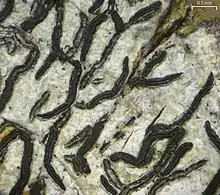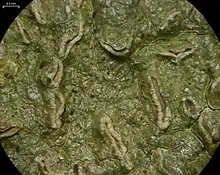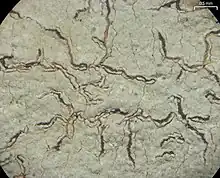Graphidaceae
The Graphidaceae are a family of lichen-forming fungi in the order Graphidales. The family contains nearly a hundred genera and more than 2000 species.[4] Although the family has a cosmopolitan distribution, most Graphidaceae species occur in tropical regions, and typically grow on bark.[5]
| Graphidaceae | |
|---|---|
 | |
| Graphis desquamescens | |
| Scientific classification | |
| Domain: | Eukaryota |
| Kingdom: | Fungi |
| Division: | Ascomycota |
| Class: | Lecanoromycetes |
| Order: | Graphidales |
| Family: | Graphidaceae Dumort. (1822) |
| Type genus | |
| Graphis Adans. (1763) | |
| Subfamilies | |
| |
| Synonyms[1][2][3] | |
Taxonomy
Graphidaceae was originally proposed by French botanist Barthélemy Charles Joseph Dumortier in 1822 (as "Graphineae"). Graphis, Opegrapha, and Arthonia were included in the new family.[6]
In 2002, German lichenologist Bettina Staiger revised the Graphidaceae family in a monograph, proposing a new classification of genera that was widely accepted until molecular phylogenetic studies led to a further reorganization of the family.[7]
Two subfamilies are recognized in the Graphidaceae:[5]
- Fissurinoideae Rivas Plata, Lücking & Lumbsch (2011)[1]
- Graphidoideae Rivas Plata, Lücking & Lumbsch (2011)[1]
Subfamily Redonographoideae, proposed by Lücking and colleagues in 2013,[8] has since been promoted to familial status.[9]
Synonymy
The family Thelotremataceae was placed in synonymy with Graphidaceae in 2008, after molecular phylogenetic analysis showed that the families formed several lineages within one strongly supported monophyletic lineage. This study also showed that many genera in Graphidaceae and Thelotremataceae were paraphyletic or polyphyletic.[10] In 2018,[11] Kraichak and colleagues, using a "temporal phylogenetic" approach to identify temporal bands for specific taxonomic ranks, proposed removing Fissurina from the Graphidaceae and instead as placing it as the type genus of Fissurinaceae, a family originally proposed by Brendan P. Hodkinson in 2012.[12] They similarly suggested recognizing Diploschistaceae and Thelotremataceae as independent families. This taxonomic proposal was rejected by Robert Lücking in a critical 2019 review of the temporal method for the classification of lichen-forming fungi, using these specific examples to highlight several drawbacks of this approach. He noted "there is substantial loss of information content in this alternative classification at the second most important rank, the level of family, and such a revised classification is practically meaningless. It makes more sense to apply such essentially phylogenetic classifications, with less information content, to infraranks, such as subfamily or tribe".[3]
Description
The photosynthetic partner (photobiont) of Graphidaceae fungi is typically green algae from the genus Trentepohlia, or very rarely Trebouxia. The lichen thallus is typically crustose, which means it forms a crust-like structure on the substrate it grows on. The form of the ascomata of Graphidaceae are usually apothecioid (cup-shaped), lirellate (narrow, and slit-like) or perithecioid (round or oval-shaped structure and embedded in the substrate), but can be rarely mazaediate (with a powdery mass of ascospores and paraphyses formed by the disintegration of the asci). They are usually zeorine (with both a thalline exciple and a proper exciple), but are sometimes lecideine (without a thallus margin) or lecanorine (surrounded by a pale thalline margin). The hamathecium, which is the hyphae and tissue that between the asci, consists of usually unbranched, sometimes capitate, rarely branched and anastomosing paraphyses. In some lineages, the paraphyses may be apically spinulose (covered with small spines or projections at the tips), and there may be lateral priphysoids in some lineages. The asci are annelasceous, which means they have a ring structure protruding into the lumen and with an apical tholus. They are non-amyloid or amyloid in some lineages, such as in the genus Diorygma. The asci are clavate to oblong or fusiform in shape.[5]
The ascospores of Graphidaceae number primarily 8 per ascus but can often be reduced to 2–4 or 1 per ascus. They are transversely septate to muriform (elongated and divided into multiple compartments by transverse and longitudinal septa), usually ellipsoid to oblong, and often have endospore forming distosepta and lens-shaped to rounded lumina. This particular set of features is known as "graphidoid". The spores can be hyaline (colourless) to (dark) brown, and the endospore is often amyloid. Graphidaceae also have pycnidia for producing conidia, which are non-septate, usually oblong, and hyaline.[5]
Distribution and ecology
The vast majority of Graphidaceae species are restricted to the tropics. Most Graphidaceae species are epiphytic (i.e. they grow only on plants).[8] Forty-two species are known from the Galápagos Islands, where they are among the most diverse of the crustose lichens there.[13] Mexico is thought to be a biodiversity hotspot of undiscovered Graphidaceae species, with about 430 species predicted to occur in tropical regions,[14] compared to less than 200 recorded in the entire country.[15]
Genera
According to the Catalogue of Life, there are 94 genera and more than 2100 species in Graphidaceae.[4] In terms of number of species, Graphidaceae is the second-largest family of lichen-forming fungi, after the Parmeliaceae (2765 species) and ahead of the Verrucariaceae (943 species).[2] The following list gives the genus name, its taxonomic authority, year of publication, and the number of species:

.jpg.webp)
.jpg.webp)

_Figure_5B.jpg.webp)
_Figure_2D.jpg.webp)
.jpg.webp)
- Acanthothecis Clem. (1909)[16] – 5 spp.
- Acanthotrema Frisch (2006)[17] – 1 sp.
- Aggregatorygma M.Cáceres, Aptroot & Lücking (2014)[18] – 3 spp.
- Allographa Chevall. (1824)[19] – 183 spp.
- Amazonotrema Kalb & Lücking (2009)[20] – 1 sp.
- Ampliotrema Kalb (2006)[21] – 1 sp.
- Anomalographis Kalb (1992) – 2 spp.
- Anomomorpha Nyl. ex Hue (1891) – 8 spp.
- Asteristion Leight. (1870) – 7 spp.[22]
- Astrochapsa Parnmen, Lücking & Lumbsch (2012)[23] – 29 spp.
- Austrotrema I.Medeiros, Lücking & Lumbsch (2017) – 3 spp.[22]
- Borinquenotrema Merc.-Díaz, Lücking & Parnmen (2014) – 1 sp.
- Byssotrema M.Cáceres, Aptroot & Lücking (2014) – 1 sp.
- Carbacanthographis Staiger & Kalb (2002)[7] – 22 spp.
- Chapsa A.Massal. (1860)[24] – 51 spp.
- Chroodiscus (Müll.Arg.) Müll.Arg. (1890) – 17 spp.
- Clandestinotrema Rivas Plata, Lücking & Lumbsch (2012)[1] – 17 spp.
- Compositrema Rivas Plata, Lücking & Lumbsch (2012) – 4 spp.
- Corticorygma M.Cáceres, S.C.Feuerst., Aptroot & Lücking (2014) – 1 sp.
- Creographa A.Massal. (1860) – 1 spp.
- Cruentotrema Rivas Plata, Papong, Lumbsch & Lücking (2012)[1] – 6 spp.
- Crutarndina Parnmen, Lücking & Lumbsch (2012)[23] – 1 sp.
- Cryptoschizotrema Aptroot, Lücking & M.Cáceres (2019) – 1 sp.
- Cyclographina D.D.Awasthi (1979) – 8 spp.
- Diaphorographis A.W.Archer & Kalb (2009)[25] – 2 spp.
- Diorygma Eschw. (1824) – 74 spp.
- Diploschistes Norman (1852)[26] – 25 spp.
- Dyplolabia A.Massal. (1854) – 5 spp.
- Enigmotrema Lücking (2012) – 1 sp.
- Fibrillithecis Frisch (2006)[17] – 15 spp.
- Fissurina Fée (1825) – 117 spp.
- Flegographa A.Massal. (1860) – 1 sp.
- Gintarasia Kraichak, Lücking & Lumbsch (2013)[27] – 7 spp.
- Glaucotrema Rivas Plata & Lumbsch (2012)[28] – 5 spp.
- Glyphis Ach. (1814) – 7 spp.
- Graphina Müll.Arg. (1880) – 25 spp.
- Graphis Adans. (1763) – ca. 275 spp.
- Gyrotrema Frisch (2006)[17] – 6 spp.
- Halegrapha Rivas Plata & Lücking (2011)[29] – 9 spp.
- Heiomasia Nelsen, Lücking & Rivas Plata (2010)[30] – 3 spp.
- Hemithecium Trevis. (1853) – ca. 50 spp.
- Janseella Henn. (1899) – 1 sp.
- Jocatoa R.Miranda (2020)[15] – 1 sp.
- Kalbographa Lücking (2007)[31] – 5 spp.
- Leiorreuma Eschw. (1824) – 18 spp.
- Leptotrema Mont. & Bosch (1856) – 14 spp.
- Leucodecton A.Massal. (1860) – 32 spp.
- Malmographina M.Cáceres, Rivas Plata & Lücking (2011) – 1 sp.
- Mangoldia Lücking, Parnmen & Lumbsch (2012) – 2 spp.[32]
- Melanotopelia Lumbsch & Mangold (2008) – 4 spp.
- Melanotrema Frisch (2006) – 12 spp.
- Myriochapsa M.Cáceres, Lücking & Lumbsch (2013) – 3 spp.
- Myriotrema Fée (1825) – 76 spp.
- Nadvornikia Tibell (1984)[33] – 5 spp.
- Nitidochapsa Parnmen, Lücking & Lumbsch (2013) – 5 spp.
- Ocellularia G.Mey. (1825) – 343 spp.
- Pallidogramme Staiger, Kalb & Lücking (2008) – 13 spp.
- Paratopeliopsis Merc.-Díaz, Lücking & Parnmen (2014) – 1 sp.
- Phaeographina Müll.Arg. (1882) – 11 spp.
- Phaeographis Müll.Arg. (1882) – ca. 180 spp.
- Phaeographopsis Sipman (1997) – 3 spp.
- Phaeotrema Müll.Arg. (1887) – 19 spp.
- Platygramme Fée (1874) – 30 spp.
- Platythecium Staiger (2002) – 27 spp.
- Pliariona A.Massal. (1860) – 1 sp.
- Polystroma Clemente (1807) – 1 sp.
- Pseudochapsa Parnmen, Lücking & Lumbsch (2012)[23] – 18 spp.
- Pseudoramonia Kantvilas & Vězda (2000)[34] – 4 spp.
- Pseudotopeliopsis Parnmen, Lücking & Lumbsch (2012)[23] – 4 spp.
- Pycnotrema Rivas Plata & Lücking (2012) – 2 spp.
- Redingeria Frisch (2006)[17] – 8 spp.
- Reimnitzia Kalb (2001)[35] – 1 sp.
- Rhabdodiscus Vain. (1921)[36] – 36 spp.
- Sanguinotrema Lücking (2015)[37] – 1 sp.
- Sarcographa Fée (1825) – 37 spp.
- Sarcographina Müll.Arg. (1887) – 6 spp.
- Schistophoron Stirt. (1876) – 5 spp.
- Schistostoma Stirt. (1879) – 1 sp.
- Schizotrema Mangold & Lumbsch (2009)[38] – 7 spp.
- Stegobolus Mont. (1845) – 16 spp.
- Thalloloma Trevis. (1853) – 20 spp.
- Thecaria Fée (1825) – 4 spp.
- Thecographa A.Massal. (1860) – 3 spp.
- Thelotrema Ach. (1803) – 165 spp.
- Topeliopsis Kantvilas & Vězda (2000)[34] – 20 spp.
- Tremotylium Nyl. (1865) – 4 spp.
- Wirthiotrema Rivas Plata, Kalb, Frisch & Lumbsch (2010) – 5 spp.
- Xalocoa Kraichak, Lücking & Lumbsch (2013)[27]– 1 sp.
References
- Rivas Plata, Eimy; Lücking, Robert; Lumbsch, H. Thorsten (2011). "A new classification for the family Graphidaceae (Ascomycota: Lecanoromycetes: Ostropales)". Fungal Diversity. 52 (1): 107–121. doi:10.1007/s13225-011-0135-8.
- Lücking, Robert; Hodkinson, Brendan P.; Leavitt, Steven D. (2017). "The 2016 classification of lichenized fungi in the Ascomycota and Basidiomycota–Approaching one thousand genera". The Bryologist. 119 (4): 361–416. doi:10.1639/0007-2745-119.4.361. JSTOR 44250015. S2CID 90258634.
- Lücking, Robert (2019). "Stop the abuse of time! Strict temporal banding is not the future of rank-based classifications in fungi (including lichens) and other organisms". Critical Reviews in Plant Sciences. 38 (3): 199–253. doi:10.1080/07352689.2019.1650517. S2CID 202859785.
- "Graphidaceae". Catalogue of Life. Species 2000: Leiden, the Netherlands. Retrieved 25 March 2023.
- Jaklitsch, Walter; Baral, Hans-Otto; Lücking, Robert; Lumbsch, H. Thorsten (2016). Frey, Wolfgang (ed.). Syllabus of Plant Families: Adolf Engler's Syllabus der Pflanzenfamilien. Vol. 1/2 (13 ed.). Berlin Stuttgart: Gebr. Borntraeger Verlagsbuchhandlung, Borntraeger Science Publishers. p. 141. ISBN 978-3-443-01089-8. OCLC 429208213.
- Dumortier, B.C.J. (1822). Commentationes botanicae (in French). Tournay: C. Casterman-Dieu. pp. 69, 78.
- Staiger; B. (2002). Die Flechtenfamilie Graphidaceae: Studien in Richtung einer natürlichen Gliederung [The lichen family Graphidaceae: studies towards a natural organization]. Bibliotheca Lichenologica (in German). Vol. 85. Berlin/Stuttgart: J. Cramer. p. 98. ISBN 978-3-443-58064-3.
- Lücking, Robert; Tehler, Anders; Bungartz, Frank; Rivas Plata, Eimy; Lumbsch, H. Thorsten (2013). "Journey from the west: did tropical Graphidaceae (lichenized Ascomycota: Ostropales) evolve from a saxicolous ancestor along the American Pacific Coast?". American Journal of Botany. 100 (5): 844–856. doi:10.3732/ajb.1200548. PMID 23594913.
- Wijayawardene, Nalin; Hyde, Kevin; Al-Ani, LKT; Dolatabadi, S; Stadler, Marc; Haelewaters, Danny; et al. (2020). "Outline of Fungi and fungus-like taxa". Mycosphere. 11: 1060–1456 [1102]. doi:10.5943/mycosphere/11/1/8.
- Mangold, Armin; Martín, María P.; Lücking, Robert; Lumbsch, H. Thorsten (2008). "Molecular phylogeny suggests synonymy of Thelotremataceae within Graphidaceae (Ascomycota: Ostropales)". Taxon. 2: 476–486. doi:10.2307/25066016.
- Kraichak, Ekaphan; Huang, Jen-Pan; Nelsen, Matthew; Leavitt, Steven D.; Lumbsch, H. Thorsten (2018). "A revised classification of orders and families in the two major subclasses of Lecanoromycetes (Ascomycota) based on a temporal approach". Botanical Journal of the Linnean Society. 188 (3): 233–249. doi:10.1093/botlinnean/boy060.
- Hodkinson, Brendan P. (2012). "An evolving phylogenetically based taxonomy of lichens and allied fungi" (PDF). Opuscula Philolichenum. 4: 4–10.
- Bungartz, Frank; Lücking, Robert; Aptroot, André (2010). "The family Graphidaceae (Ostropales, Lecanoromycetes) in the Galapagos Islands". Nova Hedwigia. 90 (1–2): 1–44.
- Lücking, Robert; Johnston, Mark K.; Aptroot, André; Kraichak, Ekaphan; Lendemer, James C.; Boonpragob, Kansri; et al. (2014). "One hundred and seventy-five new species of Graphidaceae: closing the gap or a drop in the bucket?" (PDF). Phytotaxa. 189 (1): 7–38. doi:10.11646/phytotaxa.189.1.4. S2CID 86086808.
- Miranda-González, Ricardo; Lücking, Robert; Barcenas-Peña, Alejandrina; Ángeles Herrera-Campos, María de los (2020). "The new genus Jocatoa (Lecanoromycetes: Graphidaceae) and new insights into subfamily Redonographoideae". The Bryologist. 123 (2): 127–143. doi:10.1639/0007-2745-123.2.127.
- Clements, F.E. (1909). The Genera of Fungi (1 ed.). p. 59.
- Frisch, A. (2006). The lichen family Thelotremataceae in Africa. Bibliotheca Lichenologica. Vol. 92. p. 77. ISBN 978-3-443-58071-1.
- Cáceres, Marcela; Aptroot, André; Parnmen, Sittiporn; Lücking, Robert (2014). "Remarkable diversity of the lichen family Graphidaceae in the Amazon rain forest of Rondônia, Brazil". Phytotaxa. 189 (1): 87–136. doi:10.11646/phytotaxa.189.1.8.
- Chevallier, F.F. (1824). Histoire des Graphidées, accompagné d'un tableau analytique des genres. Ouvrage renfermant des observations anatomiques et physiologiques sur ces végétaux (in French). Paris: Firmin Didot Père et fils. p. 16.
- Kalb, Klaus (2009). "New taxa and new records of thelotremoid Graphidaceae" (PDF). Herzogia. 22: 17–24.
- Kalb, K. (2004). "New or otherwise interesting lichens. II". Bibliotheca Lichenologica. 88: 301–329.
- Medeiros, Ian D.; Kraichak, Ekaphan; Lücking, Robert; Mangold, Armin; Lumbsch, H. Thorsten (2017). "Assembling a taxonomic monograph of tribe Wirthiotremateae (lichenized Ascomycota: Ostropales: Graphidaceae)". Fieldiana Life and Earth Sciences. 9: 1–31. doi:10.3158/2158-5520-16.9.1.
- Parnmen, Sittiporn; Lücking, Robert; Lumbsch, H. Thorsten (2012). "Phylogenetic classification at generic level in the absence of distinct phylogenetic patterns of phenotypical variation: a case study in Graphidaceae (Ascomycota)". PLOS ONE. 7 (12): e51392. Bibcode:2012PLoSO...751392P. doi:10.1371/journal.pone.0051392. PMC 3520900. PMID 23251515.
- Massalongo, A.B. (1860). "Esame comparativo di alcune genere di licheni". Atti dell'Istituto Veneto Scienze (in Italian). 5 (3): 247–276.
- Kalb, Klaus; Archer, Alan W.; Sutjaritturakan, Jutarat; Boonpragob, Kansri (2009). "New or otherwise interesting lichens V". Bibliotheca Lichenologica. 99: 225–246.
- Norman, J.M. (1852). "Conatus praemissus redactionis novae generum nonnullorum Lichenum in organis fructificationes vel sporis fundatae". Nytt Magazin for Naturvidenskapene [New Magazine for the Natural Sciences] (in Latin). 7: 213–252.
- Kraichak, Ekaphan; Parnmen, Sittiporn; Lücking, Robert; Lumbsch, H. Thorsten (2013). "Gintarasia and Xalocoa, two new genera to accommodate temperate to subtropical species in the predominantly tropical Graphidaceae (Ostropales, Ascomycota)". Australian Systematic Botany. 26 (6): 466. doi:10.1071/sb13038.
- Rivas Plata, E.; Lücking, R.; Lumbsch, H.T. (2012). "Molecular phylogeny and systematics of the Ocellularia clade (Ascomycota: Ostropales: Graphidaceae)". Taxon. 61 (6): 1161–1179. doi:10.1002/TAX.616001. S2CID 91389692.
- Lücking, Robert; Rivas Plata, Eimy; Kalb, Klaus; Common, Ralph S.; Barcenas Peña, Alejandrina; Duya, Melizar V. (2011). "Halegrapha (Ascomycota: Graphidaceae), an enigmatic new genus of tropical lichenized fungi dedicated to Mason E. Hale Jr". The Lichenologist. 43 (4): 331–343. doi:10.1017/s0024282911000302. S2CID 85774831.
- Nelsen, Matthew P.; Lücking, Robert; Plata, Eimy Rivas; Mbatchou, Joelle S. (2010). "Heiomasia, a new genus in the lichen-forming family Graphidaceae (Ascomycota: Lecanoromycetes: Ostropales) with disjunct distribution in Southeastern North America and Southeast Asia". The Bryologist. 113 (4): 742–751. doi:10.1639/0007-2745-113.4.742.
- Lücking, R. (2007). "Kalbographa: Monografie einer unerkannten Flechtengattung". Bibliotheca Lichenologica (in German). 96: 185–192.
- Lücking, R.; Sittiporn Parnmen, H.; Lumbsch, H. Thorsten (2012). "Mangoldia, a new lichen genus in the family Graphidaceae (Ascomycota: Ostropales)". Phytotaxa. 69. doi:10.11646/PHYTOTAXA.69.1.1. S2CID 86338523.
- Tibell, L. (1984). "A reappraisal of the taxonomy of Caliciales". Beihefte zur Nova Hedwigia. 79: 597–713 [672].
- Kantvilas, Gintaras; Vězda, Antonín (2000). "Studies on the lichen family Thelotremataceae in Tasmania. The genus Chroodiscus and its relatives". The Lichenologist. 32 (4): 325–357. doi:10.1006/lich.2000.0274.
- Kalb, Klaus (2001). "The lichen genus Topeliopsis in Australia and remarks on Australian Thelotremataceae". Mycotaxon. 79: 319–328.
- Vainio, Edvard A. (1921). "Lichenes insularum Philippinarum III". Annales Academiae Scientiarum Fennicae. A (in Latin). 15 (6): 184.
- Lücking, Robert; Mangold, Armin; Rivas Plata, Eimy; Parnmen, Sittiporn; Kraichak, Ekaphan; Lumbsch, H. Thorsten (2015). "Morphology-based phylogenetic binning to assess a taxonomic challenge: a case study in Graphidaceae (Ascomycota) requires a new generic name for the widespread Leptotrema wightii". Botanical Journal of the Linnean Society. 179 (3): 436–443. doi:10.1111/boj.12327.
- Mangold, A.; Elix, J.A.; Lumbsch, H.T. (2009). "Thelotremataceae". Flora of Australia. Vol. 57. Australian Biological Resources Study/CSIRO Publishing. pp. 653–659. ISBN 978-0-643-09664-6.
